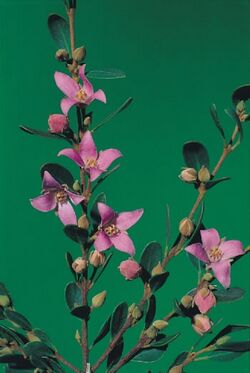Biology:Boronia ruppii
| Rupp's boronia | |
|---|---|

| |
| Scientific classification | |
| Kingdom: | Plantae |
| Clade: | Tracheophytes |
| Clade: | Angiosperms |
| Clade: | Eudicots |
| Clade: | Rosids |
| Order: | Sapindales |
| Family: | Rutaceae |
| Genus: | Boronia |
| Species: | B. ruppii
|
| Binomial name | |
| Boronia ruppii Cheel[1]
| |
Boronia ruppii, commonly known as Rupp's boronia,[2] is a species of plant in the citrus family Rutaceae and is endemic to a small area in New South Wales. It is a shrub with hairy branches, simple and trifoliate leaves and pink, four-petalled flowers in the leaf axils. It only grows around the abandoned Woodsreef asbestos mine.
Description
Boronia ruppii is a shrub that grows to a height of 0.4–2 m (1 ft 4 in–6 ft 7 in) with hairy younger branches. The leaves are simple and trifoliate, the leaves and leaflets elliptic to spatula-shaped, 4–18 mm (0.16–0.71 in) long and 3–8 mm (0.12–0.31 in) wide on a petiole 1–3 mm (0.04–0.1 in) long. The flowers are pale to bright pink and are arranged singly in or in groups of up to three in leaf axils on a pedicel 3–8 mm (0.1–0.3 in) long. The four sepals are triangular to egg-shaped, 2–5 mm (0.08–0.2 in) long and 1–3 mm (0.04–0.1 in) wide. The four petals are 6–11 mm (0.24–0.43 in) long and 3–4.5 mm (0.1–0.2 in) wide. The eight stamens alternate in length with those near the sepals slightly longer than those near the petals. Flowering mainly occurs from July to December and the fruit is a glabrous capsule 4–6 mm (0.16–0.24 in) long and 3–3.5 mm (0.1–0.1 in) wide.[2][3][4][5]
Taxonomy and naming
Rupp's boronia was first formally described in 1928 by Edwin Cheel who published the description in Journal and Proceedings of the Royal Society of New South Wales from a specimen collected by Herman Rupp.[6][7] The specific epithet (ruppii) honours the collector of the type specimen.[7]
Distribution and habitat
Boronia ruppii grows in dry woodland on soils derived from serpentinite and only occurs around the abandoned Woodsreef asbestos mine near Barraba.[3]
Conservation status
This boronia is listed as "endangered" under the New South Wales Government Biodiversity Conservation Act 2016. The main threats to the species are grazing by domestic livestock, feral and native animals, inappropriate fire regimes, clearing and habitat disturbance, and its small population size.[8]
References
- ↑ "Boronia ruppii". Australian Plant Census. https://biodiversity.org.au/nsl/services/apc-format/display/61121. Retrieved 29 April 2019.
- ↑ 2.0 2.1 Duretto, Marco F.; Wilson, Paul G.; Ladiges, Pauline Y.. "Boronia ruppii". Australian Biological Resources Study, Department of the Environment and Energy, Canberra. https://profiles.ala.org.au/opus/foa/profile/Boronia%20ruppii. Retrieved 29 April 2019.
- ↑ 3.0 3.1 "Boronia ruppii". Royal Botanic Garden Sydney. http://plantnet.rbgsyd.nsw.gov.au/cgi-bin/NSWfl.pl?page=nswfl&lvl=sp&name=Boronia~ruppii. Retrieved 29 April 2019.
- ↑ Duretto, Marco F. (1999). "Systematice of Boronia section Valvatae sensu lato (Rutaceae)". Muelleria 12 (1): 43–45. https://www.rbg.vic.gov.au/documents/Pages_from_Muelleria_12(1),_p1-46,_Duretto,_Sytematics_Boronia.pdf. Retrieved 29 April 2019.
- ↑ "Boronia ruppii (a shrub) - endangered species listing". New South Wales Government Office of Environment and Heriatage. https://www.environment.nsw.gov.au/determinations/BoroniaRuppiiEndSpListing.htm. Retrieved 29 April 2019.
- ↑ "Boronia ruppii". APNI. https://id.biodiversity.org.au/instance/apni/466421. Retrieved 13 February 2019.
- ↑ 7.0 7.1 Cheel, Edwin (1928). "Descriptions of four new species of Boronia with notes on certain other species". Journal and Proceedings of the Royal Society of New South Wales 61: 404–405. https://www.biodiversitylibrary.org/item/173698#page/462/mode/1up. Retrieved 29 April 2019.
- ↑ "Rupp's Boronia - profile". New South Wales Government Office of Environment and Heritage. https://www.environment.nsw.gov.au/threatenedspeciesapp/profile.aspx?id=10100. Retrieved 29 April 2019.
Wikidata ☰ Q15389883 entry
 |

